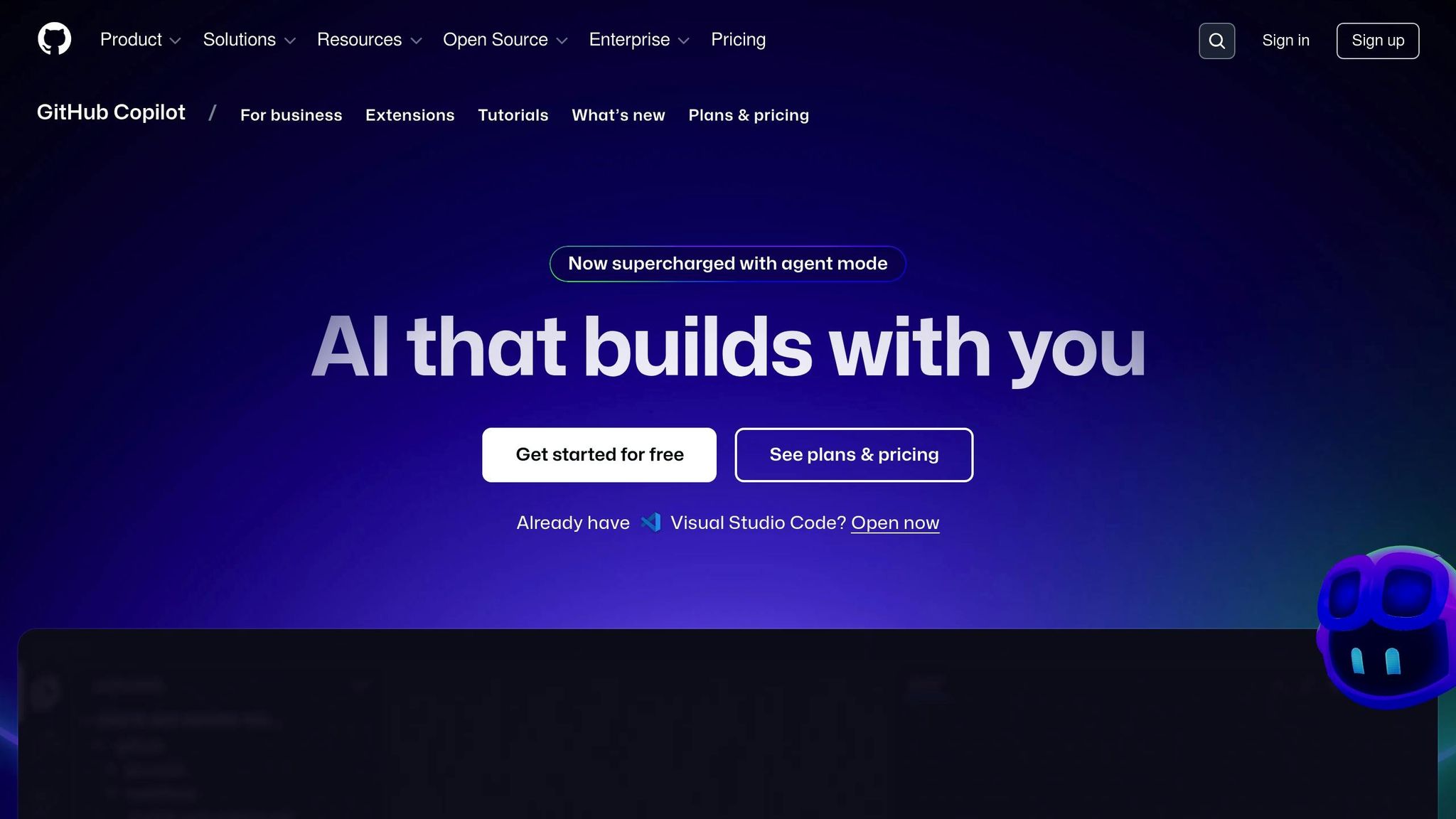Want to improve your code coverage quickly and efficiently? AI tools can help. They automate test case generation, identify edge cases, and adjust tests as your code changes, saving time and effort while increasing reliability.
Key Benefits of AI for Testing:
- Speed: Automates test creation and runs tests in parallel.
- Accuracy: Spots overlooked edge cases and critical code paths.
- Adaptability: Keeps tests updated as your code evolves.
How to Get Started:
- Pick the Right Tools: Use platforms like the Vibe Coding Tools Directory to find AI solutions that integrate well with your setup.
- Set Up Automation: Define goals, automate triggers, and integrate tools into your workflow.
- Generate Tests: Focus on critical paths, edge cases, and let AI handle the heavy lifting.
AI-powered tools make testing smarter and faster, ensuring your code is reliable and easy to maintain. Ready to boost your coverage? Let’s dive in!
Boost Code Coverage with GitHub Copilot Agent Mode ...

Why AI Helps Code Coverage
AI is changing the way testing is done by using machine learning to automate tasks and improve code coverage. This leads to faster and smarter testing processes that can keep up with changing codebases.
Faster Testing Process
AI-driven tools can speed up test case generation by analyzing code and automatically creating relevant scenarios. Here's how they help:
- Automated Analysis: Quickly review code structure and dependencies.
- Parallel Processing: Run multiple test cases at the same time for efficiency.
- Less Manual Work: Reduce the need for manual test creation.
Improved Test Cases
AI can spot important code paths and edge cases that human testers might miss. By analyzing past data and recognizing patterns, AI tools deliver more focused and thorough test coverage:
- Highlight critical parts of the code and uncover rare conditions needing tests.
- Use risk-based testing to focus on areas most likely to have bugs.
Smarter Test Updates
One standout feature of AI in testing is its ability to adjust test cases as the code changes. When new code is added or existing code is modified, AI tools can:
- Detect Code Changes: Identify updates that may impact current tests.
- Update Test Scripts: Automatically revise tests to match the latest code.
- Maintain Coverage: Ensure tests remain effective as the code evolves.
Platforms like the Vibe Coding Tools Directory make it easier for developers to take advantage of these AI features, helping them keep their test suites up-to-date without constant manual effort.
How to Use AI for Code Coverage
Using AI for code coverage starts with a clear plan. The first step? Choosing the right tools to fit your needs.
Pick Your AI Tools
Check out the Vibe Coding Tools Directory for AI testing solutions. When evaluating tools, focus on these factors:
- Integration: Make sure they work smoothly with your development setup.
- Language support: Confirm they support your programming languages.
- Ease of use: Look for good documentation and an intuitive interface.
- Handling large codebases: Ensure they can manage your project's scale.
Choosing tools that fit seamlessly into your workflow makes it easier to improve your code coverage without unnecessary headaches.
Set Up Your Workflow
Integrating AI tools into your continuous integration process requires some upfront work. Here's how to set things up:
- Prepare your environment: Install necessary dependencies and handle authentication.
- Define your goals: Set clear coverage targets and testing priorities.
- Automate triggers: Configure automated actions, like running tests on pull requests.
Once this is in place, you can shift your attention to generating tests.
Generate Test Cases
With your workflow ready, you can use AI to create tests that help maintain code reliability. AI tools analyze your code and generate test cases for various scenarios. To get the most out of this:
- Focus on critical code paths first.
- Let AI uncover edge cases that manual testing might miss.
- Use historical data to guide test creation.
- Regularly review and refine the tests AI generates.
The Vibe Coding Tools Directory simplifies this process by offering tools that adapt to the specific needs of your codebase. This approach saves time and ensures your tests cover more ground with less manual effort.
sbb-itb-7101b8c
Solving Common Testing Problems
Here's how AI tools tackle some of the biggest challenges in maintaining high code coverage.
Speed Up Test Writing
AI tools make test creation faster by analyzing your codebase and automatically generating test cases. For example, tools in the Vibe Coding Tools Directory can:
- Create test scenarios and data for edge cases
- Spot coverage gaps and recommend fixes
- Simplify test creation for intricate code paths
These tools don't just save time - they also ensure your tests stay aligned with changes in your code.
Keep Tests Current
Keeping tests in sync with changing code can be tough. AI tools simplify this process by detecting updates in your code and adjusting your test suite accordingly. Here's what they can do:
- Update tests to stay relevant
- Remove outdated test cases
- Create tests for newly added features
- Track and manage older tests to ensure they remain useful
This means your tests won't just keep up - they'll stay sharp, even as your code evolves.
Test Complex Code
When dealing with complex codebases, testing can become a real challenge. AI steps in by:
- Analyzing code paths to find rare conditions
- Testing boundary cases effectively
- Generating data combinations that go beyond what humans can manage
This AI-driven approach makes it easier to test intricate logic while ensuring your code gets the coverage it needs.
Tips for AI Testing Success
Structured AI testing is crucial, but how do you make it work? Here are some actionable strategies:
Start Small to Build Confidence
Kick things off with a small, well-documented codebase. Focus on something with minimal dependencies and clear requirements. Testing a single module or component first helps you see how the AI interprets your code and generates tests without overwhelming complexity.
Focus on Critical Areas First
When dealing with larger projects, prioritize the most important parts of your application. This includes sections like financial transactions, security features, core logic, high-traffic flows, or data processing. A clear plan for tackling these areas ensures thorough testing where it matters most.
Track Results and Fine-Tune Regularly
- Set Measurable Goals: Keep an eye on metrics like coverage percentage, test execution time, failure rates, false positives, and bugs caught.
- Review Regularly: Schedule routine reviews to analyze test outcomes and coverage reports.
- Adapt as Needed: Use patterns in results, gaps in coverage, or performance issues to refine your approach over time.
Conclusion
AI-driven testing tools are changing how developers approach code coverage, making it faster and less labor-intensive. This shift allows for smoother integration into your daily development process.
The Vibe Coding Tools Directory helps simplify the adoption of AI-assisted testing, letting teams expand their testing efforts while prioritizing code quality. With automated features, developers can achieve thorough test coverage without getting stuck in repetitive work.
To get started, focus on a single component, document your current testing process, and establish clear goals - like target coverage percentages and execution times.
For the best results, integrate AI testing tools into your workflow while keeping human oversight in place. Regularly reviewing tests ensures they meet project needs and maintain quality. By continuously refining your approach, your AI-enhanced tests will grow alongside your code.


